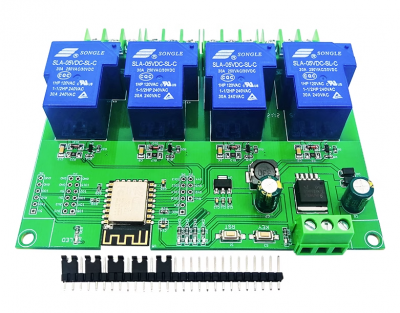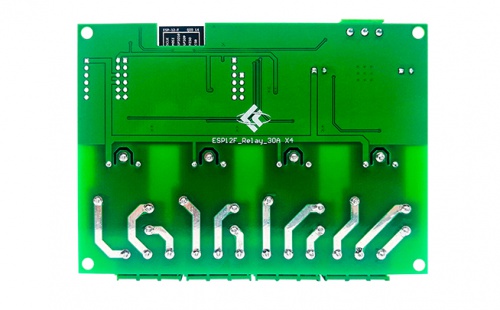LC-WF-4-4
Contents
Product name
DC7-28/5V supply power ESP8266 WiFi 4 way 30A relay module ESP-12F development secondary development
LC-WF-4-4 view
Overview
LC ESP8266 four way 30A relay development board is equipped with the ESP-12FWiFi module, with all I/O leads, and supports DC7-28V/5V power supply. Provides Arduino development environment reference code, suitable for ESP8266 secondary development learning, smart home wireless control and other occasions.
Function features
1.Onboard mature and stable ESP-12FWiFi module, large capacity 4M Byte Flash
2.The I/O port and UART program download port of the WiFi module are all lead out to facilitate secondary development
3.Power supply mode supports DC7-28V/5V
4.Onboard WiFi module RST reset button and a programmable button
5.ESP-12F supports the use of development tools such as Eclipse/Arduino IDE and provides reference programs for the Arduino development environment
6.Onboard 4-channel 5V/30A relays output switching signals, suitable for controlling loads with operating voltages within AC 250V/DC30V
7.Onboard power indicator, 1 programmable LED and relay indicator
Hardware introduction and description
1.Board size:122.5*87mm Weight:160g
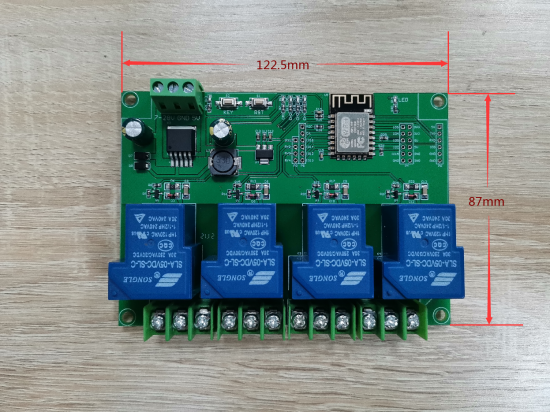
2.Interface introduction
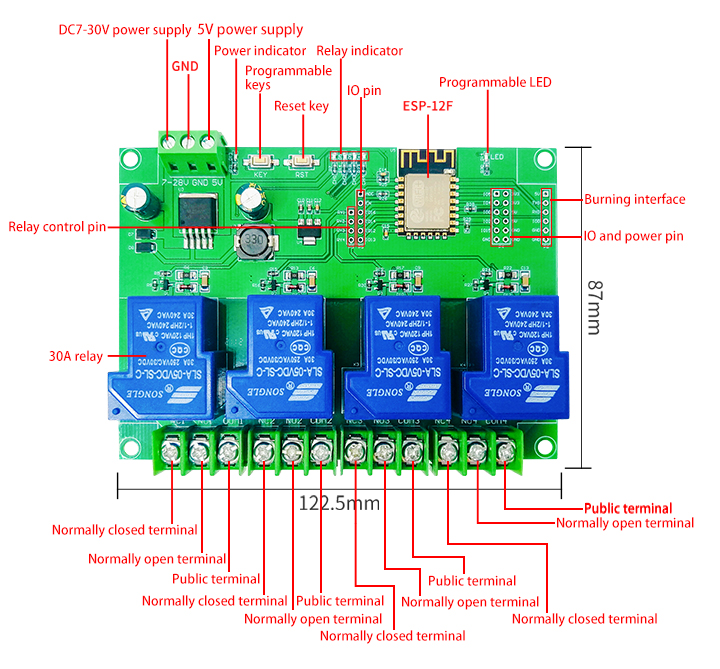
Programming port: GND, RX, TX and 5V of ESP8266 are respectively connected to GND, TX, RX and 5V of the external TTL serial port module,When downloading, IO0 needs to be connected to GND. After the download is completed, disconnect the connection between IO0 and GND.
Relay output terminals:
NC: Normally closed terminal, short-circuited to COM before the relay is closed, and left floating after closing;
COM: public terminal;
NO: Normally open terminal, the relay is left floating before closing, and short-circuited to COM after closing.
3.GPIO pinout port introduction
| NO. | Name | Function Description | NO. | Name | Function Description |
| 1 | ADC | A/D conversion result. Input voltage range: 0~1V, value range: 0~1024 | 11 | IO15 | GPIO15;MTDO; HSPI_CS;UART0_RTS |
| 2 | EN | Enable pin, pull-up by default | 12 | TXD | UART0_TXD;GPIO1 |
| 3 | IO16 | GPIO16 | 13 | RXD | UART0_RXD;GPIO3 |
| 4 | IO14 | GPIO14;HSPI_CLK | 14 | GND | Power ground |
| 5 | IO12 | GPIO12;HSPI_MISO | 15 | 5V | 5V power |
| 6 | IO13 | GPIO13;HSPI_MOSI;UART0_CTS | 16 | 3.3V | 3.3V power |
| 7 | IO5 | GPIO5 | 17 | RY1 | The first relay drive port can be short-circuited using a short-circuit cap and IO16;To use other I/O to drive relays, use Dupont wire jumpers |
| 8 | IO4 | GPIO4 | 18 | RY2 | The second relay drive port can be short-circuited using a short-circuit cap and IO14;To use other I/O to drive relays, use Dupont wire jumpers |
| 9 | IO0 | GPIO0 | 19 | RY3 | The third relay drive port can be short-circuited using a short-circuit cap and IO12;To use other I/O to drive relays, use Dupont wire jumpers |
| 10 | IO2 | GPIO2;UART1_TXD | 20 | RY4 | The fourth relay drive port can be short-circuited using a short-circuit cap and IO13;To use other I/O to drive relays, use Dupont wire jumpers |
4.Arduino development environment setup
ESP8266 supports development tools such as Eclipse/Arduino IDE. Using Arduino is relatively simple. The following is how to set up the Arduino development environment:
(1)Install Arduino IDE 1.8.9 or the latest version
(2)Open Arduino IDE, click File--Preferences in the menu bar, enter Preferences, and click Add URL in "Additional Development Board Manager URL":http://arduino.esp8266.com/stable/package_esp8266com_index.json
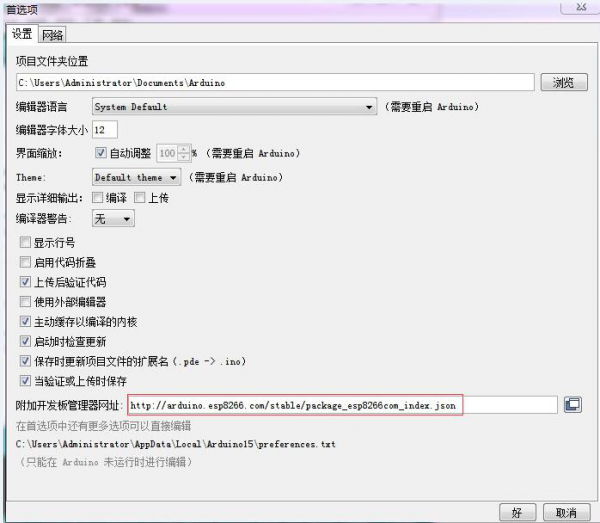
(3)Click Tools--Development Board--Development Board Manager in the menu bar, search for "ESP8266" and install Arduino's support package for ESP8266 2.5.2 or the latest version.
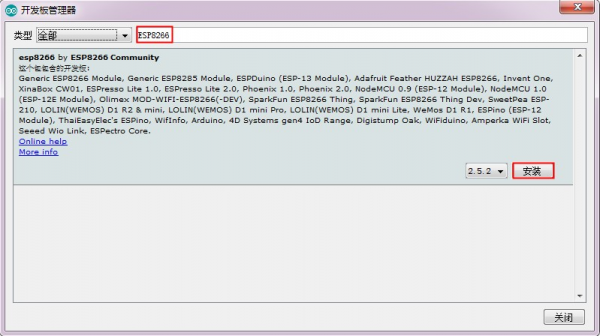
Note: Since the download website is from abroad, the access speed is relatively slow, and download errors may occur. Just try a few more times when the network is good.
5.Program download
(1)Use a jumper cap to connect the IO0 and GND pins, prepare a TTL serial port module (for example: FT232) and plug it into the computer USB. The connection method between the serial port module and the development board is as follows:
| TTLserial port module | ESP8266 development board |
| GND | GND |
| TX | RX |
| RX | TX |
| 5V | 5V |
(2)Click Tools--Development Board in the menu bar and select the development board as ESPino (ESP-12 module).
(3)Open the program you want to download, click Tools--Port on the menu bar, and select the correct port number.
(4)After clicking "Upload", the program will be automatically compiled and downloaded to the development board, as follows:
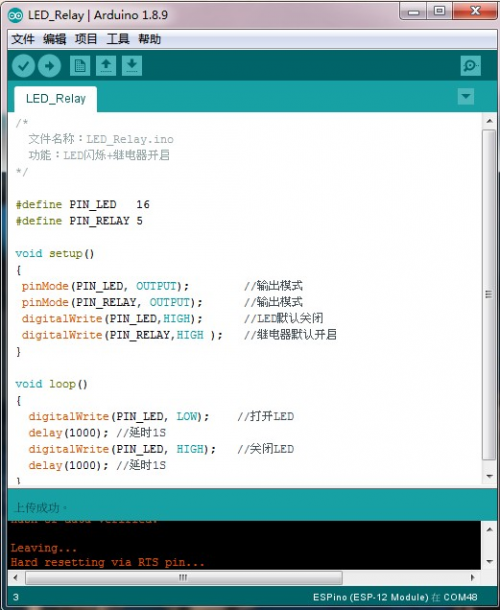
(5)It is best to disconnect IO0 and GND, power on the development board again or press the reset button to run the program.
Download LC-WF-4-4 user manual
For more information about the use of LC-WF-4-4, please click Baidu Netdisk extraction code: rml1
